"It doesn't matter what country or what political system you are from. Space brings you together."
Valentina Tereshkova

APOLLO-SOYUZ: THE FIRST INTERNATIONAL MISSION
In the Apollo Soyuz test project, the Soviet Union and the United States agreed to dock an Apollo capsule and Soyuz spacecraft. This historic mission in 1975 featured American astronauts Tom Stafford, Vance Brand and Deke Slayton. The Soviet crew consisted of Valeri Kubasov and the first spacewalker, Alexei Leonov. Together, the countries developed hardware to allow the previously incompatible spacecraft to securely connect and perform joint operations. The crews trained in both the United States and the Soviet Union.

SKYLAB: AMERICA’S FIRST SPACE STATION
Forget about science fiction movies like 2001: A Space Odyssey, where space stations look like comfortable lofts with glittering walls. Reality is another: space modules are tremendously uncomfortable. Of course, it's one thing to go to the Moon and back in 8 days, but it is different to stay in orbit around the Earth for months. That's why, before making Skylab 1, the first space station, NASA has long wondered how to make astronauts feel comfortable. Therefore, before the final launch of the module - which took place with no crew on 14 May 1973 - engineers and scientists designed the first orbital station in great detail. Before then, NASA's missions had never engaged astronauts for a very long time, but after the conquest of the Moon the space agency decided to aim even higher. The idea was to use Skylab 1 as an outpost to train the new pioneers of the solar system. And there comes the first problem: how to make the 3 crew members feel comfortable inside a module smaller than a single room apartment? To find the best solution, the famous industrial designer Raymond Loewy was involved in the design of the living spaces. The design included areas for relaxation, a panoramic window to observe the Earth and an almost spasmodic attention was given to the colour schemes of the interior lights. Since NASA was interested in understanding in advance what the crew's needs would be once in orbit, the agency sent an expert aboard an American submarine to study life in cramped and inhospitable environments.

SOVIET COSMONAUT SURVIVAL RADIO-BEACON-BEEPER *KOMAR*
The Soviet radio-beacon "KOMAR" what means "mosquito" in Russian. This device helps the rescuers to find the cosmonauts after landing. The name of the radio transmitter reminds the signal what this beacon-beeper sends out when turned on. The orange inflatable cone is visible from the long distance after the beacon coordinates are determined by radio-radars. Such radio-beacons were used by the early Soviet spacecraft cosmonauts to be easy found if they land far from the expected area.
The beacon-beeper has interesting design - its body is quite heavy and its orange cone is inflatable by pressurized air what is containing in a special ballon. When the ballon trigger is pulled by a cosmonaut, the air inflates the orange cone what stands vertically after this procedure. The antenna is in the cone, so it stands vertically too, what is the best position for radio signal transmitting.

FLIGHT SUIT OF ALEXEI LEONOV
Alekséi Arjípovich Leónov is a Russian cosmonaut who made the first spacewalk on 18th March 1965, by coming out of the capsule in which he was travelling, for some 12 mts and 9 seconds as extra vehicular activity. He died last year at the age of 85 during 2019. Leonov was one of twenty pilots of the Soviet Air Force selected to be part of the first group of cosmonauts in 1960. Like all Soviet cosmonauts, Leonov was a member of the Communist Party of the Soviet Union. Another of his greatest achievements was to be the Russian commander of the first joint Apollo-Soyuz mission. This was the costume design for that mission. Leonov defeated astronaut Ed White for three months, being the first man to go into space. The Voskhod capsule carried two men into space, just like the American Gemini capsule. There were moments of tension when Leonov once in space tried to return to the capsule. The swollen suit did not allow him to penetrate the capsule. He had to deflate him losing pressure and putting his life at risk.

SEAT RUSSIAN SOYUZ ROCKET
This is the seat of the Soviet Soyuz rocket. In this tiny cabin astronauts have to spend 2 days before arriving at the international space station. Over the years since the 1970s, the shape and the anchoring systems of the seats of the Soyuz spacecraft have not changed much. To carry it out, a study is made of the astronaut's back, making the molds that later create the impression of the chair. Each astronaut has his own place.

EARLY SOVIET SPACE STATION SALYUT WATER AND JUICE DRINKER FOR COSMONAUTS
The Cosmonauts drinker made for the first orbital space station Salyut. The device has 2 sockets marked "WATER" and "JUICE" closed by special valves. When cosmonauts connect to this drinker with their personal space flasks - they push the valve what let the liquid (water or juice) go into the flasks. The also also has ON/OFF switch and the indication light. The drinker has a built-in design to be integrated with the space station interior. It's front cover can be opened. There is a manual rubber pump with a hose attached to it under the cover of the drinker. In addition to the pump, there is a cylindrical adapter for connection to personal cosmonauts flasks with several valves inside the drinker. The drinker was made for on-Earth training copy of the space station, so, cosmonauts had study its functionality prior the mission.

RUSSIAN COSMONAUT'S WATER-COOLING UNDERGARMENT FOR EVA IN ORLAN SPACESUIT
This is a undergarment for cooling the Orlan D space suit that used in 1979 by Valery Rjumin (Валерий Рюмин) who entered the space on the space station Saljut-6 during the 175 days orbital flight. Unique case in history when the suit was actually brought back from space in order to check the condition of the wires and additional testing. The undergarment can be used with spacesuits with both manual and automatic thermal control systems. The suit is a meshy garment made of a knitted net-looking fabric through which elastic pipes of a cooling system are woven. The garment fits tightly to the body, pressing the pipes of the cooling system close to a cosmonaut body. The mesh structure of the fabric facilitates access of ventilating air to the surface of a human body. The suit can be used with spacesuits equipped with both manual and automatic thermal control systems. The principles of operation and its basic design solutions are the same as in the earlier version of the suit.
Made individually for every single cosmonaut.

RUSSIAN SPACE CAMERA
Soviet engineers pioneered the use of cameras on spacecraft, obtaining the first images of the farside of the Moon and the first images from the surface of the Moon and Venus. Soviet planetary spacecraft used cycloramic and swept linear photometers rather than vidicon television cameras. On later American missions, the Viking lander's panoramic camera and the Mars Odyssey linear pushbroom camera hark back to Soviet camera designs. This one it’s a External Chrysolite VideoCamera for the Mir Station first and installed on ISS afterwards.

COMMUNICATION CAP - TITOV
It belonged to Gherman Stepanovich Titov, who was the second man to go to space and the first tospend 24 hours inside the capsule. Gagarin and he disputed the first seat to space losing it in favorof Yuri Gagarin.

WHO IS THE YOUNGEST ASTRONAUT?
The youngest person to make it to space was a cosmonaut, Gherman Titov. Titov was just five weeks short of his 26th birthday, when he made it to space, in 1961.
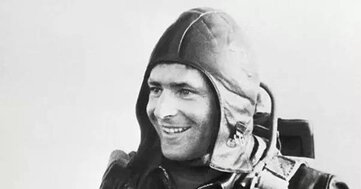
The youngest astronaut to reach space was Sally Ride, in 1983. She was 32 years and threeweeks old. Fifteen cosmonauts have flown younger than Sally Ride.
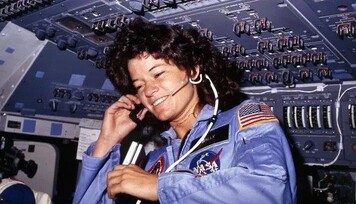

RUSSIAN HIGH-ALTITUDE FLIGHT SUIT VMSK-4
The Russian high-altitude flight suit VMSK-4 is similar to the SK-1, which Gagarin wore, with underwear. The SK-1 spacesuit was a type of emergency and rescue suit, which cosmonauts put on for launch and re-entry. Interestingly, even the first spacesuits had a waste collection system, so they didn’t have to be taken off when a cosmonaut needed to answer the call of nature. In the event of cabin depressurization, for example, the spacesuits would have supported the cosmonauts for five hours. The VMSK-4 is the model developed in the following years, designed to provide individual life support to spacecraft crews operating over ground and sea at high altitudes. The suit has its rubberized neck drape, as well as its original tag sewn into the inside shoulder, numerous pockets on the front side and two pockets on the back with GP- 2M-1 gloves inside, which are tethered to the suit. As the SK-1 this suit has a waste collection system.

THE SPACE TRANSPORTATION SYSTEM
The Space shuttle, or space transportation system, was the first reusable spacecraft designed for low Earth Orbit.
The Space shuttle consist of three separate parts: the orbiter that carried the cargo and the crew, the white solid rocket boosters and the external tank that carried the fuel needed for launch. The shuttle program consisted of 135 flight from April 12, 1981 through July 21, 2011. The fleet includes five orbiters; Columbia, Challenger, Discovery, Atlantis and Endeavour. The program pushed the boundaries of human spaceflight with the deployment and repair of the Hubble Space Telescope, groundbreaking micro-gravity research and completion of the International Space Station.

THE SPACE SHUTTLE’S COCKPIT
The space shuttle orbiter flight deck serves as the cockpit of the vehicle. With controls for electrical, life support and propulsion systems, as well as joysticks for steering during landing, the forward flight deck is the heart of the vehicle. Throughout the entire mission, the pilot and commander use this area to monitor and maintain the health of the vehicle. The commander sits on the left, with the pilot on the right. Both crew members are trained in all of the orbiter’s systems and are fully capable of flying the vehicle.

SPACE SHUTTLE PAYLOAD CONTROLS
The aft flight deck seats additional crew members, known as mission specialists, during launch and landing. Once on-orbit, the aft panels and controls focus on the cargo in the payload bay. In this area are controls to open and close the payload bay doors, and joysticks to operate the mechanical arm or Canadarm. Customized control panels designed specifically for a particular mission are installed in aft panels. There are also two sets of windows, one on the back wall used to monitor ongoing spacewalks, and two overhead windows to monitor docking procedures.

SPACE SUIT LES – Space Shuttle
The Launch Entry Suit (LES), known as the "pumpkin suit", is a partial-pressure suit that was wornby all Space Shuttle crews for the ascent and entry portions of flight from STS-26 (1988) to STS- 65 (1994). It was completely phased out by STS-88 (late 1998) and replaced by the ACES suit. The suit was manufactured by the David Clark Company of Worcester, Massachusetts. The LES was first worn by U.S. Air Force pilots replacing a similar suit worn by SR-71 and U-2pilots, and was identical to the suits worn by X-15 pilots and Gemini astronauts. Each suit was sized individually, although most suits could be worn by astronauts of differentheights. It included a parachute and flotation device.

THERMAL PROTECTION TILE FROM THE BURAN SPACECRAFT. THE 1980S.
It was used on the Buran ship as a thermal protection. This is a ceramic tile made for the Soviet space shuttle Buran. The Buran was a Soviet effort to replicate the American space shuttle program. The spacecraft had one voyage, without a crew in November 1988. After that, the program was cancelled. For years, there has been speculation as to how close a replica the Buran was to its American analogs. Like the American shuttle, the Soviets used three kinds of materials to protect the craft from the extreme temperatures of reentry. The leading edges of the nose and wing were protected with carbon fiber reinforcement. The underside of the craft was protected by black tiles and the upper side by white ceramic tiles. And also similar to the American case, each Soviet tile was marked with a serial number to that its location and performance would be documented over time. It can withstand temperatures up to 1500 degrees Celsius. The tile is very light, made of a special quartz material. The cost of making such tiles in the 1980s was 500 rubles, which was 2-2.5 salaries of an engineer.

NASA SPACE SHUTTLE COLUMBIA OV-102 ORBITER EXTERNAL FIT CHECK REFERENCE TILE
The Orbiter's Thermal Protection System (TPS) was a major innovation in the space age with the project of creating the first reusable space vehicle, the Columbia Space Shuttle, depending on its success. The TPS consists of various materials applied to the outer surface of the orbiter for protection in extreme temperatures, primarily during re-entry into the Earth's atmosphere. The orbiter's vulnerable aluminum structure could not withstand temperatures above 350 degrees F, and TPS materials were the only defense against its exposure. During re-entry the TPS materials performed in temperature ranges from minus 250 degrees F, in the cold soak of space, to atmospheric re- entry temperatures that reach 3,000 degrees F. Installing the re-entry enabling TPS tiles onto each Space Shuttle was not only one of the most critical stages involved in the orbiter assembly, it was incredibly complex as well. This artifact was used by technicians as a reference to aid with those rigorous calculations on the OV-102 Columbia. Fit Check Tiles, such as this one, were each custom designed and fabricated to be temporarily installed on the Columbia Orbiter's body, as a reference in testing size/shape within the Orbiter's tile configuration.

LIFE JACKET APOLLO - Jim Irwin
Russian Soyuz capsules do not fall on the sea but land on the Siberian steppes, where they impact like bullets on the ground. On occasion, contact with cosmonauts has been lost. In the event that the loss of contact will last for hours, even days, cosmonauts are endowed with various objects in order to survive in the immensity of the steppe. A set of flares with which to mark the position, a life jacket in the event that the capsule deviated and fell into the sea, as well as a survival kit with food rations and other basic utensils such as flashlights, Swiss army knives, etc...
In this situation this American Life Jacket was always present inside the kit because the command module always landed on the sea.

SNOOPY CAP – Alan Bean
One of the problems that arose when preparing space travel was the communication of astronauts while they were wearing their space suits. Within the helmet, they needed communication devices with which to communicate both with the mission control and with each other. The solution that was found and is still used today is to wear a hat in which microphones and headphones that allow communication are installed.

SLEEPING BAG SPACE SHUTTLE
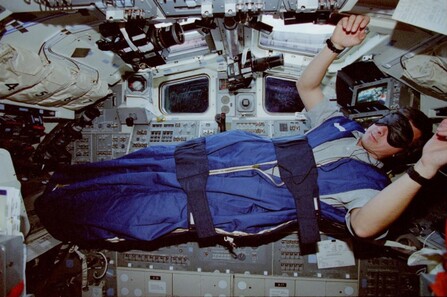
STS062-22-010 - STS-062 – Pilot Andrew Allen in sleep restraints aboard Columbia
You are ready for your bed now, but there are no beds on space. A sleeping bag is attached to one of the walls of your cabin with bungee cords instead. With no need to support your body and head against gravity, you sleep vertically in Space, not horizontally. You poke your arms through the holes, and as you relax, your hands float out in front of you, making you look a little like a marauding zombie. Some astronauts find it difficult to sleep like this, so they fold their arms or tuck them inside the sleeping bag. You can shorten the cords so you’re more tightly bound to the wall. Others enjoy the freedom of floating around the cabin during their slumber, although you might just bump into things and startle yourself awake. Being trussed up also mean it takes a longer to free yourself if you need to make a trip the bathroom in the night.

SALLY RIDE: America’s First Woman in Space | January 1981
In January 1981, Sally Ride became the first American woman in space, marking a significant milestone for NASA and women in science and technology. Her journey inspired generations to pursue careers in fields once thought unattainable.
Sally famously stated, “I’ve discovered that half the people would love to go into space... If someone doesn’t know why, I can’t explain it.” This quote captures the wonder of space exploration, shared by many dreamers.
Her mission coincided with the inaugural flight of the Space Shuttle program. John Young, commander of STS-1, remarked, “The stars don’t look bigger, but they do look brighter,” emphasizing the awe of space. He also acknowledged the risks involved, stating, “Anyone who sits on top of the largest hydrogen-oxygen-fueled system... and doesn’t get a little worried, does not fully understand the situation.”
Together, Sally Ride and John Young embody the spirit of exploration, reminding us that the dream of space exploration continues to inspire those who dare to reach for the stars.

WHEN WAS THE LAST SPACE SHUTTLE FLIGHT?
It has been 13 years since NASA's space shuttle Atlantis completed its final mission, STS-135, on July 8, 2011. This flight marked the end of the Space Shuttle program, which was crucial in advancing human spaceflight since the early 1980s. The mission, which almost didn't occur due to budget constraints, successfully delivered the Raffaello Multi-Purpose Logistics Module to the International Space Station (ISS), highlighting the Shuttle’s essential role in supporting international cooperation in space.
Over its operational lifetime, the Shuttle program completed 135 missions, achieving significant milestones such as the deployment of the Hubble Space Telescope. The conclusion of the Shuttle program is a blend of pride and nostalgia, as it laid the groundwork for future space missions and inspired a new generation of scientists and engineers. Although the program has ended, its legacy continues to influence ongoing space exploration efforts.

WHY ARE THE COLUMBIA AND CHALLENGER SPACE SHUTTLE MISSIONS INFAMOUS?
The Columbia and Challenger space shuttle missions are infamous due to tragic accidents that resulted in the loss of their crews during flight.
Space Shuttle Columbia disintegrated upon reentry on February 1, 2003, after a successful 16-day mission in orbit. The shuttle was damaged during launch when foam insulation broke off from the external tank, compromising its thermal protection system. As Columbia reentered Earth’s atmosphere, it broke apart, resulting in the deaths of all seven astronauts on board: Rick Husband, William McCool, Michael Anderson, Kalpana Chawla, David Brown, Laurel Clark, and Ilan Ramon.
In contrast, Space Shuttle Challenger never reached orbit. On January 28, 1986, just 73 seconds after liftoff, Challenger broke apart due to the failure of an O-ring in one of its Solid Rocket Boosters (SRBs). This catastrophic failure led to the loss of seven crew members: Francis Scobee, Michael Smith, Ronald McNair, Ellison Onizuka, Judith Resnik, Christa McAuliffe, and Gregory Jarvis. The Challenger disaster was a wake-up call regarding the risks of space travel and raised significant concerns about NASA's safety protocols.
Both tragedies highlighted the dangers of human spaceflight and prompted a reassessment of safety practices within NASA, ensuring that the legacies of Columbia and Challenger are never forgotten in the pursuit of exploration.
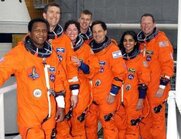
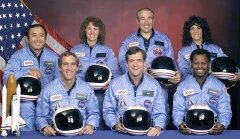

WHICH SPACE SHUTTLE MISSIONS HAD THE HIGHEST IMPACT?
I think we have to ask the question: highest impact on *what*? To our mind, the whole shuttle program had a
huge impact on technology and the way we get into space. It also delivered spectacular results for science, allowing astronauts to perform experiments in low gravity that could not be done on the Earth.
The shuttle allowed the US and dozens of partner countries to build the
International Space Station, which has been a major success and is delivering some incredible science results as well as pioneering new space technologies, new ways of manufacturing, and researching the effects of long-term space travel, among many other biology experiments.
But my own “favourite” impact was that the shuttle allowed astronauts to service and upgrade the Hubble Space Telescope, without which there would have been no observatory.

